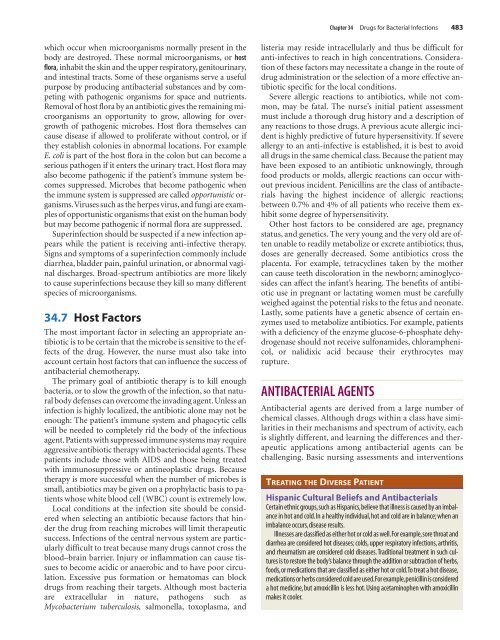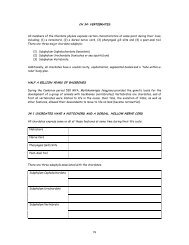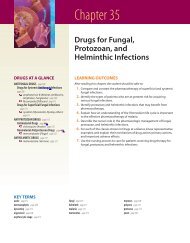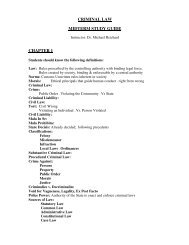Antimicrobial Drugs
Antimicrobial Drugs
Antimicrobial Drugs
You also want an ePaper? Increase the reach of your titles
YUMPU automatically turns print PDFs into web optimized ePapers that Google loves.
M34_ADAM9811_03_SE_CH34.QXD 12/30/09 1:16 PM Page 483<br />
Chapter 34 <strong>Drugs</strong> for Bacterial Infections 483<br />
which occur when microorganisms normally present in the<br />
body are destroyed. These normal microorganisms, or host<br />
flora, inhabit the skin and the upper respiratory, genitourinary,<br />
and intestinal tracts. Some of these organisms serve a useful<br />
purpose by producing antibacterial substances and by competing<br />
with pathogenic organisms for space and nutrients.<br />
Removal of host flora by an antibiotic gives the remaining microorganisms<br />
an opportunity to grow, allowing for overgrowth<br />
of pathogenic microbes. Host flora themselves can<br />
cause disease if allowed to proliferate without control, or if<br />
they establish colonies in abnormal locations. For example<br />
E. coli is part of the host flora in the colon but can become a<br />
serious pathogen if it enters the urinary tract. Host flora may<br />
also become pathogenic if the patient’s immune system becomes<br />
suppressed. Microbes that become pathogenic when<br />
the immune system is suppressed are called opportunistic organisms.Viruses<br />
such as the herpes virus, and fungi are examples<br />
of opportunistic organisms that exist on the human body<br />
but may become pathogenic if normal flora are suppressed.<br />
Superinfection should be suspected if a new infection appears<br />
while the patient is receiving anti-infective therapy.<br />
Signs and symptoms of a superinfection commonly include<br />
diarrhea, bladder pain, painful urination, or abnormal vaginal<br />
discharges. Broad-spectrum antibiotics are more likely<br />
to cause superinfections because they kill so many different<br />
species of microorganisms.<br />
34.7 Host Factors<br />
The most important factor in selecting an appropriate antibiotic<br />
is to be certain that the microbe is sensitive to the effects<br />
of the drug. However, the nurse must also take into<br />
account certain host factors that can influence the success of<br />
antibacterial chemotherapy.<br />
The primary goal of antibiotic therapy is to kill enough<br />
bacteria, or to slow the growth of the infection, so that natural<br />
body defenses can overcome the invading agent. Unless an<br />
infection is highly localized, the antibiotic alone may not be<br />
enough: The patient’s immune system and phagocytic cells<br />
will be needed to completely rid the body of the infectious<br />
agent. Patients with suppressed immune systems may require<br />
aggressive antibiotic therapy with bacteriocidal agents. These<br />
patients include those with AIDS and those being treated<br />
with immunosuppressive or antineoplastic drugs. Because<br />
therapy is more successful when the number of microbes is<br />
small, antibiotics may be given on a prophylactic basis to patients<br />
whose white blood cell (WBC) count is extremely low.<br />
Local conditions at the infection site should be considered<br />
when selecting an antibiotic because factors that hinder<br />
the drug from reaching microbes will limit therapeutic<br />
success. Infections of the central nervous system are particularly<br />
difficult to treat because many drugs cannot cross the<br />
blood–brain barrier. Injury or inflammation can cause tissues<br />
to become acidic or anaerobic and to have poor circulation.<br />
Excessive pus formation or hematomas can block<br />
drugs from reaching their targets. Although most bacteria<br />
are extracellular in nature, pathogens such as<br />
Mycobacterium tuberculosis, salmonella, toxoplasma, and<br />
listeria may reside intracellularly and thus be difficult for<br />
anti-infectives to reach in high concentrations. Consideration<br />
of these factors may necessitate a change in the route of<br />
drug administration or the selection of a more effective antibiotic<br />
specific for the local conditions.<br />
Severe allergic reactions to antibiotics, while not common,<br />
may be fatal. The nurse’s initial patient assessment<br />
must include a thorough drug history and a description of<br />
any reactions to those drugs. A previous acute allergic incident<br />
is highly predictive of future hypersensitivity. If severe<br />
allergy to an anti-infective is established, it is best to avoid<br />
all drugs in the same chemical class. Because the patient may<br />
have been exposed to an antibiotic unknowingly, through<br />
food products or molds, allergic reactions can occur without<br />
previous incident. Penicillins are the class of antibacterials<br />
having the highest incidence of allergic reactions;<br />
between 0.7% and 4% of all patients who receive them exhibit<br />
some degree of hypersensitivity.<br />
Other host factors to be considered are age, pregnancy<br />
status, and genetics. The very young and the very old are often<br />
unable to readily metabolize or excrete antibiotics; thus,<br />
doses are generally decreased. Some antibiotics cross the<br />
placenta. For example, tetracyclines taken by the mother<br />
can cause teeth discoloration in the newborn; aminoglycosides<br />
can affect the infant’s hearing. The benefits of antibiotic<br />
use in pregnant or lactating women must be carefully<br />
weighed against the potential risks to the fetus and neonate.<br />
Lastly, some patients have a genetic absence of certain enzymes<br />
used to metabolize antibiotics. For example, patients<br />
with a deficiency of the enzyme glucose-6-phosphate dehydrogenase<br />
should not receive sulfonamides, chloramphenicol,<br />
or nalidixic acid because their erythrocytes may<br />
rupture.<br />
ANTIBACTERIAL AGENTS<br />
Antibacterial agents are derived from a large number of<br />
chemical classes. Although drugs within a class have similarities<br />
in their mechanisms and spectrum of activity, each<br />
is slightly different, and learning the differences and therapeutic<br />
applications among antibacterial agents can be<br />
challenging. Basic nursing assessments and interventions<br />
TREATING THE DIVERSE PATIENT<br />
Hispanic Cultural Beliefs and Antibacterials<br />
Certain ethnic groups,such as Hispanics,believe that illness is caused by an imbalance<br />
in hot and cold.In a healthy individual, hot and cold are in balance; when an<br />
imbalance occurs,disease results.<br />
Illnesses are classified as either hot or cold as well.For example,sore throat and<br />
diarrhea are considered hot diseases; colds, upper respiratory infections, arthritis,<br />
and rheumatism are considered cold diseases. Traditional treatment in such cultures<br />
is to restore the body’s balance through the addition or subtraction of herbs,<br />
foods,or medications that are classified as either hot or cold.To treat a hot disease,<br />
medications or herbs considered cold are used.For example,penicillin is considered<br />
a hot medicine, but amoxicillin is less hot. Using acetaminophen with amoxicillin<br />
makes it cooler.<br />
# 102887 Cust: PE/NJ/CHET Au: ADAMS Pg. No. 483<br />
Title: Pharmacology for Nurses Server: Jobs2<br />
C/M/Y/K<br />
Short / Normal<br />
DESIGN SERVICES OF<br />
S4CARLISLE<br />
Publishing Services

















